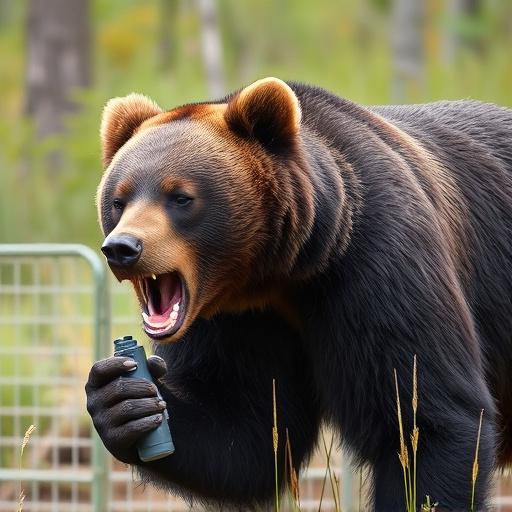Understanding bear behavior is vital for safe camping in bear country. Bear spray, containing chemicals like capsaicin (chili pepper extract), piperidine carboxylic acid (PCA) and solvents, acts as a last defense against attacks by irritating bears' eyes and nose. Choosing high-quality bear spray with effective chemicals, learning proper usage techniques, aiming for the face, keeping it readily available, storing securely, ensuring ventilation during application, avoiding wind, and checking expiration dates are essential for maximum protection during outdoor activities in bear-inhabited areas.
“Enhancing your camping experience while venturing into bear country requires an essential tool: bear defense spray. This compact yet powerful device offers a crucial layer of protection against potential encounters with these majestic yet wild creatures. In this article, we’ll explore the fundamentals of bear behavior and understand why spray is an indispensable supply. We’ll delve into the science behind its active ingredients, guide you in choosing the right spray for your needs, and provide essential tips for safe usage, ensuring a worry-free camping adventure.”
- Understanding Bear Behavior and Why Spray is Essential
- Unveiling the Active Ingredients: What Makes Bear Spray Effective?
- Choosing the Right Bear Defense Spray for Your Camping Trips
- Usage Tips and Safety Measures When Carrying Bear Spray While Camping
Understanding Bear Behavior and Why Spray is Essential
Understanding bear behavior is key when it comes to camping safely in bear country. Bears are primarily scared of humans, and they usually avoid us. However, if they feel threatened or surprise them while they’re feeding, they may attack as a defense mechanism. Bear spray, also known as bear repellent, acts as a last line of defense by creating a barrier between you and the bear, allowing you to retreat safely.
Bear sprays typically contain powerful chemicals like capsaicin, which is derived from chili peppers, and other ingredients designed to deter bears. When sprayed directly into a bear’s face, these chemicals irritate their eyes and nose, causing them to back away quickly. It’s crucial to choose a high-quality bear spray that contains effective chemicals and ensure proper usage and technique for maximum protection while camping or hiking in areas known for bear activity.
Unveiling the Active Ingredients: What Makes Bear Spray Effective?
Unveiling the Active Ingredients: The Science Behind Bear Spray’s Effectiveness
Bear spray, a crucial component of any camping supply kit, is more than just a deterrent; it’s a carefully crafted combination of specific chemicals designed to protect against aggressive bear encounters. At its core, bear spray typically contains capsaicin, the same chemical that gives chili peppers their heat. This active ingredient not only causes a stinging sensation but also temporarily blinds and disorients the bear, providing valuable time for escape or retreat.
The formula is further enhanced with other chemicals like piperidine carboxylic acid (PCA) and various solvents to ensure maximum effectiveness in diverse weather conditions. These components work synergistically to create a potent barrier, allowing users to navigate through bear country with increased safety and peace of mind. Understanding the what chemicals are in bear spray offers valuable insight into its reliability as a camping supply essential.
Choosing the Right Bear Defense Spray for Your Camping Trips
When considering bear defense spray for camping trips, it’s crucial to understand the types of chemicals used and their effectiveness. Bear sprays typically contain capsaicin, oleoresin capsicum (OC), or a combination of both. Capsaicin is derived from chili peppers and creates a burning sensation when inhaled by bears, encouraging them to flee. OC, on the other hand, is a natural substance found in hot peppers that triggers an inflammatory response in the bear’s eyes, nose, and throat, making it an effective deterrent.
Choosing the right spray depends on your specific needs and the region you’ll be camping in. Factors like weather conditions, types of bears in the area, and the distance at which you want to deter an attack influence your decision. Additionally, checking the spray’s expiration date is essential, as chemicals can degrade over time. Always follow safety instructions provided by the manufacturer for optimal protection during your outdoor adventures.
Usage Tips and Safety Measures When Carrying Bear Spray While Camping
When carrying bear spray while camping, it’s crucial to understand its usage tips and safety measures for effective protection. Familiarize yourself with the spray’s range and activation mechanism. Bear spray typically contains capsaicin, a chemical derived from chili peppers, which irritates a bear’s eyes, nose, and throat, temporarily displacing them. Aim for the face and eyes, as these areas are most sensitive. Keep in hand, ready to deploy, and be prepared to move away quickly at the first sign of a bear.
Always store bear spray in an accessible yet secure location, like a backpack or camping gear, and keep it out of reach of children and pets. Ensure proper ventilation when applying the spray, and avoid spraying directly into the wind to maximize its effectiveness. Regularly check expiration dates and practice handling the spray before setting out, ensuring you’re comfortable with its use in case of an emergency during your outdoor adventure.
Bear defense spray is a crucial addition to any camper’s essential kit. By understanding bear behavior, knowing the active ingredients that make it effective, and choosing the right product for your needs, you can enhance your safety while enjoying the great outdoors. Remember to always follow usage tips and safety measures to ensure a secure camping experience. Armed with knowledge and the right gear, you’re better prepared to navigate potential bear encounters and protect yourself in the wild.
